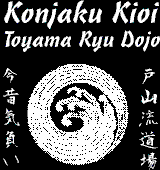 |
Toyama Ryu Batto Do Konjaku Kioi Dojo (Ancient and Modern Fighting Spirit Dojo) |
5980 66th St N Suite M St Petersburg FL 33709 Email: info@toyama-ryu.com Phone: 727-329-9679 |
|
Home
|
Code of Conduct
Konjaku Kioi Toyama Ryu Dojo(Ancient and Modern Fighting Spirit) School of Japanese Swordsmanship
Toyama Ryu Batto DoOver 200 years ago the samurai class was abolished in Japan. The Meiji Restoration redefined the class system and brought Japan into the modern era. To most people the Samurai are a footnote in history or larger than life figures on the cinema screen. The Samurai are gone, but their spirit lives on. Men and women from Japan and around the world are dedicated to keeping their legacy alive. History of Toyama RyuToyama Ryu Batto Do is a Japanese sword art formally established in 1925 for the Toyama Military academy in Japan. The Toyama academy was the Japanese equivalent of West Point founded in 1873. A committee under the senior authority of Nakayama Hakudo formalized this style to teach officers practical battlefield swordsmanship. Nakayama was the 16th soke of the Shimomura-faction of Muso Jikiden Eishin Ryu iaido. This art draws its techniques and philosophy from the expert swordsmen and their styles of that era. Its roots are in Omori Ryu Tachi Iai and the tachi waza of Muso Jikiden Eishin Ryu. It embodies the art of drawing and using the single sword from a standing posture. It teaches not only drawing and cutting techniques, but also the mental and spiritual aspects which governed the daily lives of swordsmen long ago. Emphasis of Toyama RyuToyama Ryu is based on the practical application of the sword as a weapon. It consists of basic cutting techniques, basic kata, advanced two man kata and a variety of specific cutting patterns. It places significant emphasis on the importance of actual cutting with the sword and understanding the intricate details. It focuses on not only the physical details of every action involved in using the sword, but also the mental and spiritual meaning which also must play an equal part in understanding the sword as was once done long ago. ClassesClasses are taught with the same content and format as those in Japan. This is a unique opportunity to learn authentic Japanese Swordsmanship. Classes in St Petersburg are held under the direction of Mike Femal Sensei. Femal Sensei has captured the Orlando Batto Jutsu Tai Kai championship twice and has won a dozen 1st place gold medals in both the US and in Japan. What is Batto Do?Batto Do, loosely translated, means the way of drawing and cutting with a sword in a single motion. This is the basic distinction between Batto Do and Kenjutsu, which are the fighting techniques used after the sword is drawn. Batto Do and Iaido are pretty much interchangeable. The distinction we draw here is Batto Do techniques are performed in a standing position, while traditional Iaido uses many techniques performed from seiza, or the kneeling position. TameshigiriTameshigiri, consisting of various cutting patterns and targets. Tameshigiri, the practice of test cutting, is fundamental in Batto Do. The purpose of tameshigiri is to test the cutting ability of the sword, gain experience in striking a solid object and improve timing, distance, angle and grip. The targets used consist of makiwara, tightly rolled mats called tatami mats that have been soaked in water and offer uniform weight and thickness. While kata teaches correct footwork and body movement, it is only by cutting an actual target that reveals whether or not the proper cutting technique is being used. Strength, speed and technique alone, however, are not enough. The correct swing technique and blade angle, hasuji, must combine with proper cutting distance to make a successful cut. To perform a perfect cut, the mind, body and spirit must fuse at the very instant of cutting. This is the training objective of Batto Do. |
Copyright © 2006 by Konjaku Kioi Toyama Ryu Dojo, All rights reserved.
Samurai Swords
Iaito (Practice Swords)
Shinken (Cutting Swords)
Wakizashi (Short Swords)
Tanto (Daggers)
Japanese Weapons
Maintenance
Uniforms
Sharpening
Sword Repair
Martial Arts
Dictionary Your Name in Japanese
Dojo Stories
Tatami Targets

